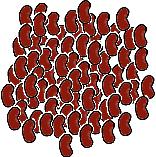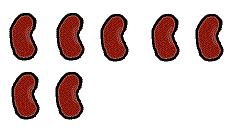Counting to One Hundred
Introduction
 In a 1997 book, The Number Sense: How the Mind
Creates Mathematics, (New York: Oxford Press), Stanislas Dehaene, a
mathematician and cognitive neuro-psychologist, reports experiments
with animals, young infants, brain-lesioned patients, and high-tech
brain-imaging tools, and reaches an interesting conclusion: Humans
have an innate ability for very basic arithmetic. Even very young
children can recognize at a glance small numbers of objects (one, two,
and three). Learning arithmetic starts with combining these small
numbers into bigger aggregates (four, five, six, ...). So a child can
see four as two and two, or as three and one. And a child can see six
as three and three, or three, two, and one.
In a 1997 book, The Number Sense: How the Mind
Creates Mathematics, (New York: Oxford Press), Stanislas Dehaene, a
mathematician and cognitive neuro-psychologist, reports experiments
with animals, young infants, brain-lesioned patients, and high-tech
brain-imaging tools, and reaches an interesting conclusion: Humans
have an innate ability for very basic arithmetic. Even very young
children can recognize at a glance small numbers of objects (one, two,
and three). Learning arithmetic starts with combining these small
numbers into bigger aggregates (four, five, six, ...). So a child can
see four as two and two, or as three and one. And a child can see six
as three and three, or three, two, and one.
In this unit we capitalize on this rudimentary number sense to suggest a new way to teach counting to young children. Typically children are taught to count objects by ones: 1, 2, 3, 4, ...; or by twos: 2, 4, 6, 8, ... . But now let's try to count by threes, twos, and ones simultaneously. Activity 1. Each child gets a plate of 50 to 100 beans. (In a package of beans, some are always broken. These should be removed. Larger beans are better for young learners.) The task is to count the beans by ones, twos, and threes. Speed is not important. The task requires sustained concentration. Most errors occur not because of miscounting, but because of lapses in attention. 2. The beans may be carefully dumped in a pile on the table, and the child will move the beans that are being counted to another pile. Here's an example 3. In this task, the child may need some advice not only about what to do, but about how to think about what he or she is doing. But advice should be given only if the teacher thinks it is really needed. In a good strategy, you always count to whole tens; you don't go from 29 to 31. And you think only the total. Do not think 29 plus one is 30. Think 29, 30. (You don't think "one", you just see it.) You have to try it yourself to see how simple and natural it becomes after a few minutes. |







